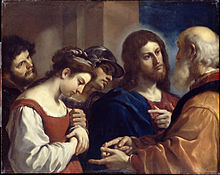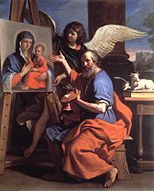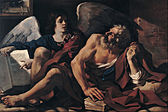art.wikisort.org - Artist
Giovanni Francesco Barbieri (February 8, 1591 – December 22, 1666),[1] better known as Guercino,[2] or il Guercino [ɡwerˈtʃiːno], was an Italian Baroque painter and draftsman from Cento in the Emilia region, who was active in Rome and Bologna. The vigorous naturalism of his early manner contrasts with the classical equilibrium of his later works. His many drawings are noted for their luminosity and lively style.
Guercino | |
|---|---|
 Self portrait, c. 1635 | |
| Born | Giovanni Francesco Barbieri February 8, 1591 Cento |
| Died | December 22, 1666 (aged 75) Bologna |
| Nationality | Italian |
| Known for | Painting, drawing |
| Movement | Baroque |
Biography

![This contemporary portrait (1623) by Ottavio Leoni[3] highlights the lifelong squint (a form of strabismus) which prompted the name 'Guercino'. Despite presumably having monocular vision due to a 'lazy' right eye, Guercino showed remarkable facility to imply depth in his works, perhaps assisted by an enhanced perception of light and shade thanks to compensation by the healthy eye.[4] Other artists with different types of strabismus include Rembrandt, Dürer, Degas, Picasso and (possibly) Leonardo da Vinci.[5]](http://upload.wikimedia.org/wikipedia/commons/thumb/e/ea/Francesco_Barbieri.jpg/220px-Francesco_Barbieri.jpg)


Giovanni Francesco Barbieri was born into a family of peasant farmers in Cento, a town in the Po Valley mid-way between Bologna and Ferrara.[6] Being cross-eyed, at an early age he acquired the nickname by which he is universally known, Guercino (a diminutive of the Italian noun guercio, meaning 'squinter').[7] Mainly self-taught, at the age of 16, he worked as apprentice in the shop of Benedetto Gennari, a painter of the Bolognese School.[8] An early commission was for the decoration with frescos (1615–1616[9]) of Casa Pannini in Cento, where the naturalism of his landscapes already reveals considerable artistic independence.[10] In Bologna, he was winning the praise of Ludovico Carracci. He always acknowledged that his early style had been influenced by study of a Madonna painted by Ludovico Carracci for the Capuchin church in Cento, affectionately known as "La Carraccina".[11]
His painting Et in Arcadia ego from around 1618–1622 contains the first known usage anywhere of the Latin motto, later taken up by Poussin and others, signifying that death lurks even in the most idyllic setting.[12] The dramatic composition of this canvas (related to his Flaying of Marsyas by Apollo (1617–1618[13]) created for The Grand Duke of Tuscany, which shares the same pair of shepherds[14]) is typical of Guercino's early works, which are often tumultuous in conception.[15] He painted two large canvases, Samson Seized by Philistines (1619) and Elijah Fed by Ravens (1620), for Cardinal Serra, a Papal Legate to Ferrara.[16][17] Painted at a time when it is unlikely that Guercino could have seen Caravaggio's work in Rome, these works nevertheless display a starkly naturalistic Caravaggesque style.
Rome


Guercino was recommended by Marchese Enzo Bentivoglio to the newly elected Bolognese Ludovisi Pope, Pope Gregory XV in 1621.[18] The years he spent in Rome, 1621–23, were very productive. From this period are his frescoes Aurora at the casino of the Villa Ludovisi, the ceiling in San Crisogono (1622) of San Chrysogonus in Glory, the portrait of Pope Gregory XV (now in the Getty Museum), and the St. Petronilla Altarpiece for St. Peter's Basilica in the Vatican (now in the Museo Capitolini).
Return to Bologna
Following the death of Gregory XV in 1623, Guercino returned to his hometown of Cento. In 1626, he began his frescoes in the Duomo of Piacenza. The details of his career after 1629 are well documented in the account book, the Libro dei Conti di Casa Barbieri, that Guercino and his brother Paolo Antonio Barbieri, a notable painter of still lifes, kept updated, and which has been preserved.[19] Between 1618 and 1631, Giovanni Battista Pasqualini produced 67 engravings that document the early production of Guercino, which is not included in the Libro dei Conti.[20] In 1642, following the death of his commercial rival Guido Reni, Guercino moved his busy workshop to Bologna, where he was now able to take over Reni's role as the city's leading painter of sacred subjects. Some of his later works are closer to the style of Reni, and are painted with much greater luminosity and clarity than his early works with their prominent use of chiaroscuro. In 1655, the Franciscan Order of Reggio paid him 300 ducats for the altarpiece of Saint Luke Displaying a Painting of the Madonna and Child (now in Nelson-Atkins Museum of Art, Kansas City).[21] The Corsini also paid him 300 ducats for the Flagellation of Christ painted in 1657.

Works and pupils
Guercino was remarkable for the extreme rapidity of his executions: he completed no fewer than 106 large altarpieces for churches, and his other paintings amount to about 144. He was also a prolific draftsman. His production includes many drawings, usually in ink, washed ink, or red chalk. Most of them were made as preparatory studies for his paintings, but he also drew landscapes, genre subjects, and caricatures for his own enjoyment. Guercino's drawings are known for their fluent style in which "rapid, calligraphic pen strokes combined with dots, dashes, and parallel hatching lines describe the forms".[22]
Guercino continued to paint and teach until his death in 1666, amassing a notable fortune. As he never married, his estate passed to his nephews and pupils, Benedetto Gennari II and Cesare Gennari.[7] Other pupils include Giulio Coralli,[23] Giuseppe Bonati of Ferrara,[24] Cristoforo Serra of Cesena,[25] Father Cesare Pronti of Ferrara,[26] Sebastiano Ghezzi,[27] Sebastiano Bombelli,[28] Lorenzo Bergonzoni of Bologna,[29] Francesco Paglia of Brescia.,[30] Benedetto Zallone of Cento, Bartolomeo Caravoglia,[31] and Matteo Loves.
Works
![Moonlit Landscape (c. 1616, oil on canvas, 55 × 71 cm, Nationalmuseum, Stockholm, Sweden).[32] An early, naturalistic landscape.](//upload.wikimedia.org/wikipedia/commons/thumb/c/c9/Moonlight_Landscape_%28Giovanni_Francesco_Barbieri_Guercino%29_-_Nationalmuseum_-_20163.tif/lossy-page1-168px-Moonlight_Landscape_%28Giovanni_Francesco_Barbieri_Guercino%29_-_Nationalmuseum_-_20163.tif.jpg) Moonlit Landscape (c. 1616, oil on canvas, 55 × 71 cm, Nationalmuseum, Stockholm, Sweden).[32] An early, naturalistic landscape.
Moonlit Landscape (c. 1616, oil on canvas, 55 × 71 cm, Nationalmuseum, Stockholm, Sweden).[32] An early, naturalistic landscape.- Harvesting (1615–1617, fresco, transferred to canvas, 18 × 23.5 cm, Pinacoteca, Cento, Italy). One of the frescos created (with the assistance of Lorenzo Gennari[6]) for Casa Pannini in Cento.[33] (Guercino himself came from a family of peasant farmers.)
- Susanna and the Elders (1617, oil on canvas, 176 × 208 cm, Museo del Prado, Madrid, Spain) was painted in Bologna for Cardinal Alessandro Ludovisi, the future Pope Gregory XV.[34] The dramatic dynamism of this early work contrasts with the studied classicism of the artist's later depiction of the same story in 1649–1650.[35]
- Samson Seized by the Philistines, 1619 This work showcases the biblical scene where Samson the Nazarite is betrayed by his lover Delilah. In the painting Samson is at the center, though is face cannot be seen, and surrounding him are the Philistines who have come to blind him after cutting off his hair, his source of strength. The men holding the tool that will be used to blind Samson can be seen as well as the man holding the scissors that had been used to cut Samson's hair. The figure in the righthand corner is interpreted to either be an angel looking on reminding Samson that his eventual sacrifice to save the Hebrews is right and seen in a good light by God or as an onlooker who was fleeing the scene but could not help from looking back.
- Return of the Prodigal Son, 1619
- St William Receiving the Monastic Habit (1620, oil on canvas, 348.5 × 231 cm, Pinacoteca Nazionale di Bologna, Italy),[36] painted for St Gregory Church in Bologna, was Guercino's largest ecclesiastical commission at the time and is considered a high point of his early career.[7]
- Aurora, (1621, ceiling fresco, tempera, 530 × 1030 cm, Villa Aurora, Rome, Italy) was painted for the pope's nephew, Cardinal Ludovico Ludovisi.[37] The lively treatment of the Aurora myth challenges the more measured representation of the same subject painted by Guido Reni at Palazzo Rospigliosi on behalf of a Ludovisi family rival and makes a statement of political triumph.[38]
- Capturing Christ, 1621
- Saint Matthew and the Angel, 1622
- La morte di Didone, 1631
- Christ and the Woman of Samaria II, c. 1640–1641
- Atlas holding up the celestial globe, 1646
- St Peter Weeping before the Virgin, 1647
- Mars with Cupid, 1649
- Cleopatra and Octavian, 1649
- Joseph and Potiphar's Wife, 1649, National Gallery of Art
- St. Cecilia, 1649
- Susanna and the Elders, 1650
- David with the Head of Goliath, circa 1650
- The Vocation of Saint Aloysius Gonzaga, 1650
- Personification of Astrology, ca. 1650–1655, Blanton Museum of Art, Texas
- The Return of the Prodigal Son, 1651
- King David, 1651
- Samson and Delilah, 1654
Exhibitions
A groundbreaking exhibition held at the Archiginnasio of Bologna in 1968 provided the most complete panorama of Guercino's work to date, including paintings from the later parts of his career after the death of Pope Gregory XV, which had previously attracted relatively little attention.[35] For the fourth centenary of the artist's birth in 1991, an expanded exhibition was organized by the Pinacoteca Nazionale di Bologna in conjunction with the Schirn Kunsthalle Frankfurt and the National Gallery of Art, Washington.[39] Both these exhibitions were curated by Guercino's biggest modern champion, Denis Mahon, who was responsible for their catalogues.[40] In 2011–2012, a large exhibition was displayed at Palazzo Barberini in Rome, dedicated to the memory of Mahon, who had recently died.[41] An exhibition displayed at the National Museum in Warsaw in 2013–2014 offered another extensive presentation of the artist's work.[42]
Citations
- Miller, 1964
- "Beside the easel". besidetheeasel.blogspot.se. Retrieved 14 September 2017.
- "Giovanni Francesco Barbieri, called Guercino - Ottavio Leoni". www.ngv.vic.gov.au. National Gallery of Victoria. Retrieved 12 February 2019.
- Scholtz et al, 2019
- Tyler, CW (18 October 2018). "Evidence That Leonardo da Vinci Had Strabismus" (PDF). JAMA Ophthalmology. 137 (1): 82–86. doi:10.1001/jamaophthalmol.2018.3833. PMC 6439801. PMID 30347053.
- Mahon, 1937a
- Turner, 2003
- Griswold 1991, p. 6
- "Casa Pannini di Cento". www.geoplan.it (in Italian). Retrieved 8 February 2019.
- Stone, pp. 3, 37.
- "La Carraccina". bbcc.ibc.regione.emilia-romagna.it (in Italian). Regione Emilia Romagna. Retrieved 9 February 2019.
- Lubbock, Tom (23 February 2007). "Guercino: Et in Arcadia Ego (1618-22)". The Independent. Retrieved 7 February 2019.
- "Palazzo Pitti: Galleria Palatina - Apollo e Marsia". www.abcfirenze.com (in Italian).
- "Et in Arcadia Ego by Guercino". www.wga.hu. Web Gallery of Art. Retrieved 8 February 2019.
- Griswold 1991, p. 13
- "Samson Captured by the Philistines". www.metmuseum.org. Metropolitan Museum of Art. Retrieved 8 February 2019.
- Vivian, 1971
- Lawrence Gowing, ed., Biographical Encyclopedia of Artists, v.2 (Facts on File, 2005): 291.
- Griswold 1991, p. 35
- Gozzi, Fausto (2006). "Sacro e Profano nelle Incisioni da Guercino" (in Italian). Culturalia. Retrieved 12 February 2019.
- "Guercino's Saint Luke Displaying a Painting of the Virgin". Smarthistory at Khan Academy. Retrieved March 15, 2013.
- Griswold 1991, p. 36
- Orlandi, 1719, p. 207
- Orlandi, p. 207
- Orlandi, p. 120.
- Orlandi, p. 350.
- Orlandi, p. 399
- Orlandi, p. 397.
- Orlandi, p. 294.
- Orlandi, p. 171
- Lanzi, 1847, pp. 309–310
- "Giovanni Francesco Barbieri Il Guercino". emp-web-84.zetcom.ch. Nationalmuseum. Retrieved 11 February 2019.
- "Barbieri Giovan Francesco, Mietitura". catalogo.fondazionezeri.unibo.it. Fondazione Zeri, University of Bologna. Retrieved 11 February 2019.
- "Susannah and the Elders - The Collection". Museo Nacional del Prado. Retrieved 11 February 2019.
- Posner, 1968
- "San Guglielmo d'Aquitania riceve l'abito religioso da San Felice Vescovo. (Vestizione di San Guglielmo)". www.pinacotecabologna.beniculturali.it (in Italian). Retrieved 13 February 2019.
- Vodret and Gozzi, 2011, pp. 159–161
- Unger, 2016, p. 9; "Aurora by Guercino". www.wga.hu. Web Gallery of Art. Retrieved 15 February 2019.
- Mahon, 1992, p. 7
- van Serooskerken, 1991
- Vodret and Gozzi, 2011
- "Guercino. Triumf baroku" [Guercino. Triumph of the Baroque]. www.legitymizm.org (in Polish). Organizacja Monarchistów Polskich. Retrieved 12 February 2019.
References
- Books and articles on Guercino
- Griswold, William M (1991). "Guercino". Metropolitan Museum of Art Bulletin. 48 (4): 5–56. doi:10.2307/3258858. JSTOR 3258858.
- Lanzi, Luigi (1847). Thomas Roscoe (translator) (ed.). History of Painting in Italy; From the Period of the Revival of the Fine Arts to the End of the Eighteenth Century. Vol. III. London: Henry G. Bohn.
{{cite book}}:|editor=has generic name (help) - Mahon, Denis (1937a). "Notes on the Young Guercino I. - Cento and Bologna". The Burlington Magazine for Connoisseurs. 70 (408): 112–122. JSTOR 866850.
- Mahon, Denis (1937b). "Notes on the Young Guercino II. - Cento and Ferrara". The Burlington Magazine for Connoisseurs. 70 (409): 177–189. JSTOR 866750.
- Mahon, Denis (1992). Guercino: Master Painter of Baroque. National Gallery of Art. ISBN 978-0-89468-167-7.
- Miller, Dwight C. (1964). "Barbieri, Giovanni Francesco detto il Guercino". Dizionario Biografico degli Italiani (in Italian). Vol. 6.
- Orlandi, Pellegrino Antonio; Guarienti, Pietro (1719), Abecedario pittorico, Naples.
- Posner, Donald (1968). "The Guercino Exhibition at Bologna". The Burlington Magazine. 110 (788): 596–607. JSTOR 875813.
- Scholtz, Sibylle; MacMorris, Lee; Krogmann, Frank; Auffarth, Gerd U (2019). "Lights and darks of a picture. The life of Giovanni Francesco Barbieri, "il Guercino" - the squinter". Strabismus. 27 (1): 39–42. doi:10.1080/09273972.2019.1559532. PMID 30626256. S2CID 58585811. (subscription required)
- van Serooskerken, Carel van Tuyll (1991). "Guercino. Bologna, Cento and Frankfurt". The Burlington Magazine. 133 (1065): 864–868. JSTOR 885077.
- Stone, David M (1991). Guercino: Catalogo Completo Dei Dipinti (in Italian). Cantini. ISBN 978-88-7737-137-9.
- Turner, Nicholas (2003). "Guercino". Oxford Art Online. Oxford Art Online (Grove Art). doi:10.1093/gao/9781884446054.article.t035416. (subscription required)
- Unger, Daniel M (2016). Guercino's Paintings and His Patrons' Politics in Early Modern Italy. ISBN 978-1-351-56482-3.
- Vivian, Frances (1971). "Guercino Seen from the Archivio Barberini". The Burlington Magazine. 113 (814): 22–29. JSTOR 876502.
- Vodret, Rossella; Gozzi, Fausto (2011). Guercino (1591-1666): capolavori da Cento e da Roma (in Italian). Giunti. ISBN 9788809775350.
Further reading
- Amorini, Antonio Bolognini (1843). "Parte Quinta". Vite de Pittori ed Artifici Bolognesi (in Italian). Tipografia Governativa alla Volpe, Bologna. pp. 223–272.
External links
| External video | |
|---|---|
 | |
| Wikimedia Commons has media related to Guercino. |
| Wikisource has the text of the 1911 Encyclopædia Britannica article "Barbieri, Giovanni Francesco". |
- 53 artworks by or after Guercino at the Art UK site
- Paintings by Guercino on the Web Gallery of Art
- Getty exhibition of Guercino drawings
- Encyclopædia Britannica, Il Guercino
- Pinacoteca Civica Il Guercino
- Virtual exhibition "Guercino a Fano" in high resolution
- Jusepe de Ribera, 1591–1652, an exhibition catalog from The Metropolitan Museum of Art (fully available online as PDF), which contains material on Guercino (see index)
- Velázquez , an exhibition catalog from The Metropolitan Museum of Art (fully available online as PDF), which contains material on Guercino (see index)
На других языках
[de] Giovanni Francesco Barbieri
Giovanni Francesco Barbieri, besser bekannt als Guercino (* 8. Februar 1591 in Cento; † 22. Dezember 1666 in Bologna) war ein italienischer Maler, Freskant und Zeichner des Barock. Sein Künstlername ist die Verkleinerungs- und Koseform zum italienischen Wort guercio („der Schieler“)[1] und bezieht sich auf einen Augenfehler, den er sich in seiner Kindheit angeblich durch einen Unfall zugezogen haben soll, wie sein Biograf Malvasia berichtet.[2]- [en] Guercino
[es] Guercino
Giovan (Giovanni) Francesco Barbieri (Cento, 8 de febrero de 1591-Bolonia, 9 de diciembre de 1666), más conocido con el apodo Guercino o Il Guercino, fue un pintor barroco italiano. Es un representante del periodo de transición del clasicismo romano-boloñés al barroco pleno. Padecía estrabismo, de ahí su sobrenombre (guercino es el diminutivo de guercio, bizco en italiano).[fr] Le Guerchin
Giovanni Francesco Barbieri, dit Guercino ou le Guerchin[1], né à Cento le 8 février 1591 et mort à Bologne le 22 décembre 1666, est un peintre et dessinateur italien baroque de l'école de Ferrare, actif à Rome et Bologne. Il est l'oncle de Benedetto Gennari le Jeune, lui-même petit-fils de Benedetto Gennari dit Seniore.[it] Guercino
Giovanni Francesco Barbieri, soprannominato il Guercino (Cento, 2 febbraio 1591 – Bologna, 22 dicembre 1666), è stato un pittore italiano.[ru] Гверчино
Гверчино (Гуэрчино, итал. Guercino — «косоглазый»; наст. имя Джованни Франческо Барбьери, Barbieri) (крещён 8 февраля 1591, Ченто, Феррара — 22 декабря 1666, Болонья) — итальянский живописец болонской школы[2].Другой контент может иметь иную лицензию. Перед использованием материалов сайта WikiSort.org внимательно изучите правила лицензирования конкретных элементов наполнения сайта.
WikiSort.org - проект по пересортировке и дополнению контента Википедии
![Moonlit Landscape (c. 1616, oil on canvas, 55 × 71 cm, Nationalmuseum, Stockholm, Sweden).[32] An early, naturalistic landscape.](http://upload.wikimedia.org/wikipedia/commons/thumb/c/c9/Moonlight_Landscape_%28Giovanni_Francesco_Barbieri_Guercino%29_-_Nationalmuseum_-_20163.tif/lossy-page1-168px-Moonlight_Landscape_%28Giovanni_Francesco_Barbieri_Guercino%29_-_Nationalmuseum_-_20163.tif.jpg)
![Harvesting (1615–1617, fresco, transferred to canvas, 18 × 23.5 cm, Pinacoteca, Cento, Italy). One of the frescos created (with the assistance of Lorenzo Gennari[6]) for Casa Pannini in Cento.[33] (Guercino himself came from a family of peasant farmers.)](http://upload.wikimedia.org/wikipedia/commons/thumb/1/1b/Guercino_La_mietitura.jpg/168px-Guercino_La_mietitura.jpg)
![Susanna and the Elders (1617, oil on canvas, 176 × 208 cm, Museo del Prado, Madrid, Spain) was painted in Bologna for Cardinal Alessandro Ludovisi, the future Pope Gregory XV.[34] The dramatic dynamism of this early work contrasts with the studied classicism of the artist's later depiction of the same story in 1649–1650.[35]](http://upload.wikimedia.org/wikipedia/commons/thumb/5/50/Susana_y_los_viejos_%28Guercino%29.jpg/168px-Susana_y_los_viejos_%28Guercino%29.jpg)


![St William Receiving the Monastic Habit (1620, oil on canvas, 348.5 × 231 cm, Pinacoteca Nazionale di Bologna, Italy),[36] painted for St Gregory Church in Bologna, was Guercino's largest ecclesiastical commission at the time and is considered a high point of his early career.[7]](http://upload.wikimedia.org/wikipedia/commons/thumb/c/c0/Guercino_Guglielmo_d%27Aquitania.jpg/111px-Guercino_Guglielmo_d%27Aquitania.jpg)
![Aurora, (1621, ceiling fresco, tempera, 530 × 1030 cm, Villa Aurora, Rome, Italy) was painted for the pope's nephew, Cardinal Ludovico Ludovisi.[37] The lively treatment of the Aurora myth challenges the more measured representation of the same subject painted by Guido Reni at Palazzo Rospigliosi on behalf of a Ludovisi family rival and makes a statement of political triumph.[38]](http://upload.wikimedia.org/wikipedia/commons/thumb/8/8b/Guercino_-_Aurora_-_WGA10920.jpg/168px-Guercino_-_Aurora_-_WGA10920.jpg)
















